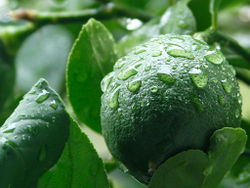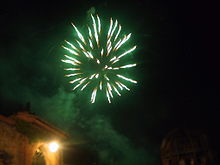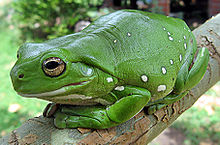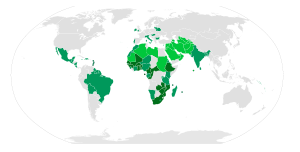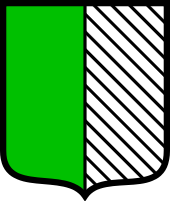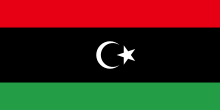- Green
-
Green — Spectral coordinates — Wavelength 520–570 nm Frequency ~575–525 THz — Common connotations — nature, growth, grass, hope, youth, sickness, health, Islam, spring, Saint Patrick's Day, money (US), and envy[1][2][3] 
— Color coordinates —
Hex triplet #00FF00 sRGBB (r, g, b) (0, 255, 0) Source sRGB approximation to NCS S 2060-G[4] B: Normalized to [0–255] (byte) Green is a color, the perception of which is evoked by light having a spectrum dominated by energy with a wavelength of roughly 520–570 nanometres. In the subtractive color system, it is not a primary color, but is created out of a mixture of yellow and blue, or yellow and cyan; it is considered one of the additive primary colors. On the HSV color wheel, also known as the RGB color wheel, the complement of green is magenta; that is, a purple color corresponding to an equal mixture of red and blue light. On a color wheel based on traditional color theory (RYB), the complementary color to green is considered to be red.[5]
The word green is closely related to the Old English verb growan, "to grow". It is used to describe plants or the ocean. Sometimes it can also describe someone who is inexperienced, jealous, or sick. In the United States of America, green is a slang term for money, among other things. Several colloquialisms have derived from these meanings, such as "green around the gills", a phrase used to describe a person who looks ill.
Several minerals have a green color, including emerald, which is colored green by its chromium content. Animals such as frogs, lizards, and other reptiles and amphibians, fish, insects, and birds, appear green because of a mixture of layers of blue and green coloring on their skin. By far the largest contributor to green in nature is chlorophyll, the chemical by which plants photosynthesize. Many creatures have adapted to their green environments by taking on a green hue themselves as camouflage.
Culturally, green has broad and sometimes contradictory meanings. In some cultures, green symbolizes hope and growth, while in others, it is associated with death, sickness, envy, or the devil. The most common associations, however, are found in its ties to nature. For example, Islam venerates the color, as it expects paradise to be full of lush greenery. Green is also associated with regeneration, fertility and rebirth for its connections to nature. Recent political groups have taken on the color as symbol of environmental protection and social justice, and consider themselves part of the Green movement, some naming themselves Green parties. This has led to similar campaigns in advertising, as companies have sold green, or environmentally friendly, products.
Contents
Etymology and linguistic definitions
 The application of terms to ranges of the visible spectrum are essentially arbitrary, cultural conventions. The notion of "green" in modern European languages corresponds to about 520–570 nm, but many historical and non-European languages make other choices, e.g. using a term for the range of ca. 450–530 nm ("blue/green") and another for ca. 530–590 nm ("green/yellow")
The application of terms to ranges of the visible spectrum are essentially arbitrary, cultural conventions. The notion of "green" in modern European languages corresponds to about 520–570 nm, but many historical and non-European languages make other choices, e.g. using a term for the range of ca. 450–530 nm ("blue/green") and another for ca. 530–590 nm ("green/yellow")
The word green comes from the Old English word grēne, earlier grœni. It is from a Common Germanic *gronja-, which is also reflected in Old Norse grænn, Old High German gruoni (but unattested in East Germanic), ultimately from a PIE root *ghre- "to grow", and root-cognate with grass and to grow.[6] The first recorded use of the word as a color term in Old English dates to ca. AD 700.[7]
Latin with viridis (and hence the Romance languages, and English vert, verdure etc.) also has a genuine term for "green". Likewise the Slavic languages with zelenъ. Ancient Greek also had a term for yellowish, pale green, χλωρός, cognate with χλοερός "verdant" and χλόη "the green of new growth".
Thus, the languages mentioned above (Germanic, Romance, Slavic, Greek) have old terms for "green" which are derived from words for fresh, sprouting vegetation. However, comparative linguistics makes clear that these terms were coined independently, over the past few millennia, and there is no identifiable single Proto-Indo-European or word for "green". For example, the Slavic zelenъ is cognate with Sanskrit hari "yellow, ochre, golden".[8] The Turkic languages also have jašɨl "green" or "yellowish green", compared to a Mongolian word for "meadow".[9]
Indeed, in the comparative study of color terms in the world's languages, green is only found as a separate category in languages with the fully developed range of six colors (white, red yellow, green, blue, black), identified as "Stage V" in Berlin and Kay (1969), or more rarely in systems with five colors (white, red yellow, green, black/blue). Many languages with a more reduced inventory of color terms have a single word for subsuming what would in English be called either blue or green, or more rarely black/blue/green or yellow/green/blue.[10]
Thus, especially the distinction of green from blue is lacking in the traditional vocabulary of many languages.[11] Modern languages have of course introduced supplementary vocabulary to denote "green", but these terms are recognizable as recent adoptions that are not in origin color terms (much like the English adjective orange being in origin not a color term but the name of a fruit). Thus, the Thai word เขียว besides meaning "green" also means "rank" and "smelly" and holds other unpleasant associations.[12]
The Celtic languages had a term for "blue/green/grey", Proto-Celtic *glasto-, which gave rise to Old Irish glas "green, grey" and to Welsh glas "blue". This word is cognate with the Ancient Greek γλαυκός "bluish green", contrasting with χλωρός "yellowish green" discussed above.
In modern Japanese, the term for green is 緑, while the old term for "blue/green", blue (青 Ao) now means "blue". But in certain contexts, green is still conventionally referred to as 青, as in in blue traffic light (青信号 Ao shingō) and blue leaves (青葉 Aoba), reflecting the absence of blue-green distinction in old Japanese (more accurately, the traditional Japanese color terminology grouped some shades of green with blue, and others with yellow tones).
The Persian language is traditionally lacking a black/blue/green distinction. The Persian word سبز sabz can bean "green", "black" or "dark". Thus, Persian erotic poetry, dark-skinned women are addressed as sabz-eh, as in phrases like سبز گندم گون sabz-eh-gandom-gun (literally "dark wheat colored") or سبز مليح sabz-eh-malih ("a dark beauty").[13] Similarly, in Sudanese Arabic, dark-skinned people are described as أخضر akhḍar, the term which in Standard Arabic stands unambiguously for "green".[14]
In science
Color vision and colorimetry
Unique green
(NCS S 2060-G)Green additive primary
The perception of greenness (in opposition to redness forming one of the opponent mechanisms in human color vision) is evoked by light which triggers the medium-wavelength M cone cells in the eye more than the long-wavelength L cones. Light which triggers this greenness response more than the yellowness or blueness of the other color opponent mechanism is called green. A green light source typically has a spectral power distribution dominated by energy with a wavelength of roughly 487–570 nm.[15]
In additive color devices such as computer displays and televisions, one of the primary light sources is typically a narrow-spectrum yellowish-green of dominant wavelength ~550 nm; this "green" primary is combined with an orangish-red "red" primary and a purplish-blue "blue" primary to produce any color in between – the RGB color model. A unique green (green appearing neither yellowish nor bluish) is produced on such a device by mixing light from the green primary with some light from the blue primary.
By contrast in process color printing, a subtractive color system, green can be produced via a mixture of cyan and yellow ink, and in traditional color theory, green is produced by mixing yellow and blue paint.
Its complement
Munsell 2.5RP 5/9An example green
Munsell 2.5G 5/9Green is complementary to a purplish red or reddish purple color, in both additive and subtractive mixtures, and in simultaneous contrast effects and afterimages.
The sensitivity of the dark-adapted human eye is greatest at about 507 nm, a bluish-green color, while the light-adapted eye is most sensitive about 555 nm, a yellowish-green color.[16] Human eyes have color receptors known as cone cells, of which there are three types. In some cases, one is missing or faulty, which can cause color blindness, including the common inability to distinguish red and yellow from green, known as deuteranopia or red–green color blindness.[17] Green is restful to the eye. Studies show that a green environment can reduce fatigue.[18]
In minerals and chemistry
Many minerals provide pigments which have been used in green paints and dyes over the centuries. Pigments, in this case, are minerals which reflect the color green, rather that emitting it through luminescent or phosphorescent qualities. The large number of green pigments makes it impossible to mention them all. Among the more notable green minerals, however is the emerald, which is colored green by trace amounts of chromium and sometimes vanadium.[19] Chromium(III) oxide (Cr2O3), is called chrome green, also called viridian or institutional green when used as a pigment.[20] For many years, the source of amazonite's color was a mystery. Widely thought to have been due to copper because copper compounds often have blue and green colors, the blue-green color is likely to be derived from small quantities of lead and water in the feldspar.[21] Copper is the source of the green color in malachite pigments, chemically known as basic copper(II) carbonate.[22] Early painters would also use copper in the form of verdigris mixed with wax and turpentine to create green pigmentation in paints.[23] Mixtures of oxidized cobalt and zinc were also used to create green paints as early as the 18th century.[24] A more complete list of green minerals and pigments can be seen here.[25]
There is no natural source for green food colorings which has been approved by the US Food and Drug Administration. Chlorophyll, the E numbers E140 and E141, is the most common green chemical found in nature, and only allowed in certain medicines and cosmetic materials.[26] Quinoline Yellow (E104) is a commonly used coloring in the United Kingdom but is banned in Australia, Japan, Norway and the United States.[27] Green S (E142) is prohibited in many countries, for it is known to cause hyperactivity, asthma, urticaria, and insomnia.[28]
To create green sparks, fireworks use barium salts, such as barium chlorate, barium nitrate crystals, or barium chloride, also used for green fireplace logs.[29] Copper salts typically burn blue, but cupric chloride (also known as "campfire blue") can also produce green flames.[29] Green pyrotechnic flares can use a mix ratio 75:25 of boron and potassium nitrate.[29] Smoke can be turned green by a mixture: solvent yellow 33, solvent green 3, lactose, magnesium carbonate plus sodium carbonate added to potassium chlorate.[29]
In biology
Green is common in nature, as many green plants use a complex chemical known as chlorophyll during photosynthesis.[17] Chlorophyll does not absorb green light because it first arose in organisms living in oceans where purple halobacteria were already exploiting photosynthesis. Their purple color arose because they extracted energy in the green portion of the spectrum using bacteriorhodopsin. The new organisms that then later came to dominate the extraction of light were selected to exploit those portions of the spectrum not used by the halobacteria.[30]
Animals typically use the color green as camouflage, blending in with the chlorophyll green of the surrounding environment.[17] Green animals include, especially, amphibians, reptiles, and some fish, birds and insects. Most fish, reptiles, amphibians, and birds appear green because of a reflection of blue light coming through an over-layer of yellow pigment. Perception of color can also be affected by the surrounding environment. For example, broadleaf forests typically have a yellow-green light about them as the trees filter the light. Turacoverdin is one chemical which can cause a green hue in birds, especially.[17] Invertebrates such as insects or mollusks often display green colors because of porphyrin pigments, sometimes caused by diet. This can causes their feces to look green as well. Other chemicals which generally contribute to greenness among organisms are flavins (lychochromes) and hemanovadin.[17] Humans have imitated this by wearing green clothing as a camouflage in military and other fields. Substances that may impart a greenish hue to one's skin include biliverdin, the green pigment in bile, and ceruloplasmin, a protein that carries copper ions in chelation.
Lasers
Lasers emitting in the green part of the spectrum are widely available to the general public in a wide range of output powers. Green laser pointers outputting at 532 nm (563.5 THz) are relatively inexpensive compared to other wavelengths of the same power, and are very popular due to their good beam quality and very high apparent brightness. The most common green lasers use diode pumped solid state (DPSS) technology to create the green light.[31] An infrared laser diode at 808 nm is used to pump a crystal of neodymium-doped yttrium vanadium oxide (Nd:YVO4) or neodymium-doped yttrium aluminium garnet (Nd:YAG) and induces it to emit 281.76 THz (1064 nm). This deeper infrared light is then passed through another crystal containing potassium, titanium and phosphorus (KTP), whose non-linear properties generate light at a frequency that is twice that of the incident beam (563.5 THz); in this case corresponding to the wavelength of 532 nm ("green").[32] Other green wavelengths are also available using DPSS technology ranging from 501nm to 543nm.[33] Green wavelengths are also available from gas lasers, including the Helium-neon laser (543 nm), the Argon-ion laser (514 nm) and the Krypton-ion laser (521 nm and 531 nm), as well as liquid dye lasers. Green lasers have a wide variety of applications, including pointing, illumination, surgery, laser light shows, spectroscopy, interferometry, fluorescence, holography, machine vision, non-lethal weapons and bird control.[34]
In culture
 In the 15th century "Saint Wolfgang and the Devil" by Michael Pacher, the Devil is green. Poets such as Chaucer also drew connections between the color green and the devil.[35]
In the 15th century "Saint Wolfgang and the Devil" by Michael Pacher, the Devil is green. Poets such as Chaucer also drew connections between the color green and the devil.[35]
Nature
In many folklores and literatures, green has traditionally been used to symbolize nature and its embodied attributes, namely those of life, fertility, and rebirth. Green was symbolic of resurrection and immortality in Ancient Egypt; the god Osiris was depicted as green-skinned.[36] It is often used to describe foliage and the sea, and has become a symbol of environmentalism. Someone who works well with plants is said to have a green thumb or green fingers, and the word greenhorn refers to an inexperienced person.[2] A company is said to be greenwashing if they advertise positive environmental practices to cover up environmental destruction.[37][38] Green is used to describe anyone young, inexperienced, or gullible (probably by analogy to unripe, i.e. unready or immature, fruit).[1] Green was the traditional color worn by hunters in the 19th century particularly the shade called hunter green. In the 20th century most hunters began wearing the color olive drab, a shade of green, instead of hunter green.[39]
Love and lust
Stories of the medieval period further portray it as representing love[40] and the base, natural desires of man.[41] In Persian and Sudanese poetry, dark-skinned women, called "green" women may be eroticized.[14] The Chinese term for cuckold is "to wear a green hat."[42] It is because in ancient China sex worker's husband wears Green Headscarf.[43] Green is also used to describe jealousy and envy.[1] In more modern times, the consumption of green M&M's has earned urban legendary status as a purported aphrodisiac.[44]
Death, decay, and evil
Green is also known to have signified witchcraft, devilry and evil for its association with faeries and spirits of early English folklore. It also had an association with decay and toxicity.[45] Actor Bela Lugosi wore green-hued makeup for the role of Dracula in the 1927–28 Broadway stage production.[46] A green tinge in the skin is sometimes associated with nausea and sickness.[47] A physically ill person is said to look green around the gills.[2] The color, when combined with gold, is seen as representing the fading of youth.[48] In the Celtic tradition, green was avoided in clothing for its superstitious association with misfortune and death.[49][50] Green is thought to be an unlucky color in British and British-derived cultures,[51] where green cars, wedding dresses, and theater costumes are all the objects of superstition.[52] Spider-Man villains were often colored green to represent a contrast to the hero's red.[53] In some Far East cultures the color green is often used as a symbol of sickness and/or nausea.[54]
Prosperity
In areas that use the U.S. Dollar as currency, green carries a connotation of money, wealth, and capitalism, because green is the color of United States banknotes, giving rise to the slang term greenback for cash.[1] One of the more notable uses of this meaning is found in The Wonderful Wizard of Oz. In this story is the Emerald City, where everyone wears tinted glasses which make everything look green. According to the populist interpretation of the story, the city’s color is used by the author, L. Frank Baum, to illustrate the financial system of America in his day, as he lived in a time when America was debating the use of paper money versus gold.[55] Green can communicate safety to proceed, as in traffic lights.[2] In China, green is associated with the east, with sunrise, and with life and growth.[56] In Thailand, the color green is consider auspicious for those born on a Wednesday day (light green for those born at night).[57]
Nationality and politics
Several countries use green on their flags for symbolic or cultural reasons. Green, for example is one of the three colors (along with red and black, or red and gold) of Pan-Africanism. Several African countries thus use the color on their flags, including South Africa, Ghana, Senegal, Mali, Ethiopia, Togo, Guinea, Benin, and Zimbabwe. The Pan-African colors are borrowed from the Ethiopian flag, one of the oldest independent African countries. Green in these cases represents the natural richness of Africa.[58]
Many flags of the Islamic world are green, as the color is considered sacred in Islam (see below). The flag of Hamas,[59] as well as the flag of Iran, is green, symbolizing their Islamist ideology.[60] The 1977 flag of Libya consists of a simple green field with no other characteristics. It was the only national flag in the world with just one color and no design, insignia, or other details.[61] In the run-up to Iran's 2009 presidential election, the reformist candidate Mir-Hossein Mousavi chose green as his campaign color, and it became pervasive among his supporters during the campaign and the post-election protests.[62] Green is the lowest of the three bands on the flag of India. The green stands for fertility and prosperity. Earlier Indian flags had contained a similar green band representing Islam, the second-most predominant religion in India.[63]
Other countries use flags for reasons of heraldry, or to represent lush national vegetation. In heraldry, green is called vert (French for "green"). Fourteenth century documents describe vert as a symbol of "jolliness and youth, but also of beauty and shame" as well as of death.[citation needed] Vert is used for the flags of Wales and Hungary, and is the basis for the Brazilian flag as well.[64][65] Other countries using green in their flags use it to represent their country's lush vegetation, as in the flag of Jamaica,[66] and hope in the future, as in the flags of Portugal and Nigeria.[67]
Green is a symbol of Ireland, which is often referred to as the "Emerald Isle". The color is particularly identified with the republican and nationalist traditions in modern times. It is used this way on the flag of the Republic of Ireland, in balance with white and the Protestant orange.[68] Green is a strong trend in the Irish holiday St. Patrick’s Day.[69]
Green has become the symbolic color of environmentalism, chosen for its association with nature, health, and growth. The Green Party is any of various political parties emphasizing ecology, grassroots democracy, nonviolence, and social justice. Green Parties, now active in over one hundred countries, are more broadly included in the green movement, and most are members of the Global Green Network.[70] The association of green with advocates of the environment has extended to other circles as well, as is the case with Patriarch Bartholomew I of Constantinople, who is often referred to as the "Green Patriarch" because the new environmental focus which he brought about within the Ecumenical Patriarchate.[71]
Religion
Green is considered the traditional color of Islam. Muhammad is reliably quoted in a hadith as saying that "water, greenery, and a beautiful face" were three universally good things.[72] In the Qur'an, sura Al-Insan, believers in God in Paradise wear fine green silk.[3][73] Also, Al-Khidr ("The Green One"), is a Qur’anic figure who met and traveled with Moses.[74]Roman Catholic and more traditional Protestant clergy wear green vestments at liturgical celebrations during Ordinary Time.[75] In the Eastern Catholic Church, green is the color of Pentecost.[76] Green is one of the Christmas colors as well, possibly dating back to pre-Christian times, when evergreens were worshiped for their ability to maintain their color through the winter season. Romans used green holly and evergreen as decorations for their winter solstice celebration called Saturnalia, which eventually evolved into a Christmas celebration.[77] In Ireland and Scotland especially, green is used to represent Catholics, while orange is used to represent Protestantism. This is shown on the national flag of Ireland.
Metaphysics
In the metaphysics of the "New Age Prophetess", Alice Bailey, in her system called the Seven Rays which classifies humans into seven different metaphysical psychological types, the "third ray" of "creative intelligence" is represented by the color green. People who have this metaphysical psychological type are said to be "on the Green Ray".[78] In Hinduism, Green is used to symbolically represent the fourth, heart chakra (Anahata).[79] Psychics who claim to be able to observe the aura with their third eye report that someone with a green aura is typically someone who is in an occupation related to health, such as a physician or nurse, as well as people who are lovers of nature and the outdoors.[80]
See also
Notes and references
- ^ a b c d "Results for "green"". Dictionary.com. Lexico Publishing Corp.. 2007. http://dictionary.reference.com/browse/green. Retrieved 2007-11-22.
- ^ a b c d Oxford English Dictionary
- ^ a b Khalifa, Rashad (trans). "Sura 76, The Human (Al-Insaan)". Quran The Final Testament. http://www.masjidtucson.org/quran/noframes/ch76.html#21. Retrieved 2007-11-30.
- ^ The sRGB values are taken by converting the NCS color 2060-G using the "NCS Navigator" tool at the NCS website.
- ^ "Glossary Term: Color wheel". Sanford Corp.. 2005. Archived from the original on November 2, 2007. http://web.archive.org/web/20071102211428/http://www.sanford-artedventures.com/study/g_color_wheel.html. Retrieved 2007-11-22.
- ^ Harper, Douglas (November 2001). "Online Etymology Dictionary". http://www.etymonline.com/index.php?search=green&searchmode=none. Retrieved 2007-11-22.
- ^ Maerz and Paul A Dictionary of Color New York:1930 McGraw-Hill Page 196
- ^ Vasmer's dictionary of Slavic etymology
- ^ Sergei Starostin, Turkic etymology
- ^ Paul Kay and Luisa Maffi, 'Color Appearance and the Emergence and Evolution of Basic Color Lexicons', American Anthropologist, March 1999[1]
- ^ Newman, Paul and Martha Ratliff. Linguistic Fieldwork. Cambridge: Cambridge University Press, 2001. ISBN 0-521-66937-5 pg. 105
- ^ "English: Thai Dictionary OnLine". 4M System. 2007. http://english-thai-dictionary.com/index.php?PHPSESSID=4f45ab7ea8c50b85369a44a3453bdb91&. Retrieved 2007-11-30.
- ^ F. Steingass, A Comprehensive Persian-English Dictionary s.v. سبز
- ^ a b Carla N. Daughtry, "Greenness in the Field," Michigan Today, University of Michigan, Fall 1997
- ^ More specifically, "blue green" 487–493 nm, "bluish green" 493–498 nm, "green" 498–530 nm, "yellowish green" 530–559 nm, "yellow green" 559–570 nm. Kenneth L. Kelly (1943). "Color Designations for Lights". Journal of the Optical Society of America 33(11). 627–632.
- ^ See color vision, scotopic vision, photopic vision.
- ^ a b c d e The New Encyclopædia Britannica. Chicago: Encyclopædia Britannica, 2002. ISBN 0-85229-787-4
- ^ Laird, Donald A. "Fatigue: Public Enemy Number One: What It Is and How to Fight It." The American Journal of Nursing (Sep 1933) 33.9 pgs. 835-841.
- ^ Hurlbut, Cornelius S. Jr, & Kammerling, Robert C., 1991, Gemology, p. 203, John Wiley & Sons, New York
- ^ A. F. Holleman and E. Wiberg "Inorganic Chemistry" Academic Press, 2001, New York.
- ^ Hoffmeister and Rossman (1985). Am. Min. 70: 794–804.
- ^ "Malachite". WebExhibits. 2001. http://webexhibits.org/pigments/indiv/overview/malachite.html. Retrieved 2007-12-08.
- ^ "Copper resinate". WebExhibits. 2001. http://webexhibits.org/pigments/indiv/overview/curesinate.html. Retrieved 2007-12-08.
- ^ "Cobalt green". WebExhibits. 2001. http://webexhibits.org/pigments/indiv/overview/cogreen.html. Retrieved 2007-12-08.
- ^ "Green Minerals Sorted By Color". Webmineral.com. http://webmineral.com/determin/green_minerals.shtml. Retrieved 2009-04-15.
- ^ Gilman, Victoria (2003-08-25). "Food Coloring: Synthetic and natural additives impart a rainbow of possibilities to the foods we eat". Chemical & Engineering News. http://pubs.acs.org/cen/whatstuff/stuff/8134foodcoloring.html. Retrieved 2007-12-08.
- ^ "E104 Quinoline Yellow, FD&C Yellow No.10". UK Food Guide. http://www.ukfoodguide.net/e104.htm. Retrieved 2007-12-09.
- ^ "E142 Green S". UK Food Guide. http://www.ukfoodguide.net/e142.htm. Retrieved 2007-12-09.
- ^ a b c d "Firework Chemicals (list)". Sylighter, Inc.. 2008. http://www.skylighter.com/mall/chemicals.asp. Retrieved 2008-01-11.
- ^ Goldsworthy, A. (10 December 1987). Why trees are green. New Scientist, 116 (1880) 48-52.
- ^ "Laserglow - Green Lasers". Laserglow.com. http://www.laserglow.com/page/greenlaserpointer. Retrieved 2011-09-27.
- ^ "Sams Laser FAQ". Sam Goldwasser. http://donklipstein.com/laserssl.htm. Retrieved 2011-09-27.
- ^ "Laserglow - DPSS Lasers". Laserglow.com. http://www.laserglow.com/int-labOEM.htm. Retrieved 2011-09-27.
- ^ "Laserglow - Green lasers for Bird Control / Abatement". Laserglow.com. http://www.laserglow.com/page/golfcoursebirdcontrol. Retrieved 2011-09-27.
- ^ Robertson, D. W. Jr. "Why the Devil Wears Green." Modern Language Notes. (Nov 1954) 69.7 pgs. 470-472
- ^ de Vries, Ad (1976). Dictionary of Symbols and Imagery. Amsterdam: North-Holland Publishing Company. pp. 226–28. ISBN 0-7204-8021-3.
- ^ Salley, Danielle (2010-08-19). "Greenwashing: The Eco-Frenemy". Four Green Steps. http://www.fourgreensteps.com/infozone/featured/features/greenwashing-the-eco-frenemy.
- ^ The article on greenwashing discusses several examples.
- ^ Maerz and Paul A Dictionary of Color New York:1930 McGraw-Hill Page 162--Discussion of color Hunter Green
- ^ Chamberlin, Vernon A. "Symbolic Green: A Time-Honored Characterizing Device in Spanish Literature." Hispania. 51.1 (Mar 1968) pp. 29-37
- ^ Goldhurst, William. "The Green and the Gold: The Major Theme of Gawain and the Green Knight." College English. 20.2 (Nov 1958) pp. 61-65 doi:10.2307/372161
- ^ Sommer, Matthew Harvey (2002). Sex, Law, and Society in Late Imperial China. Stanford: Stanford University Press. p. 218. ISBN 0804745595. http://books.google.com/?id=E6ClbegXuWUC. Retrieved 2008-07-27.
- ^ History of Ming
- ^ http://www.snopes.com/risque/aphrodisiacs/mandms.asp
- ^ Williams, Margaret. The Pearl Poet, His Complete Works. Random House, 1967.
- ^ Skal, David J. (1990). Hollywood Gothic: The Tangled Web of Dracula from Novel to Stage to Screen. Andre Deutch. p. 85. ISBN 0-233-98766-5.
- ^ Ford, Mark. Self Improvement of Relationship Skills through Body Language. City: Llumina Press, 2004. ISBN 1-932303-79-0 pg. 81
- ^ Lewis, John S. "Gawain and the Green Knight." College English. 21.1 (Oct 1959) pp. 50–51
- ^ The Idea of the Green Knight, Lawrence Besserman, ELH, Vol. 53, No. 2. (Summer, 1986), pp. 219-239. The Johns Hopkins University Press.
- ^ Why The Devil Wears Green, D. W. Robertson Jr., Modern Language Notes, Vol. 69, No. 7. (Nov., 1954), pp. 470-472. The Johns Hopkins University Press.
- ^ "Folklore and Symbolism of Green," by John Hutchings in Folklore, 1997, 108:55.
- ^ "Green is an unlucky color for automobiles". Snopes.com. 2007-02-27. http://www.snopes.com/autos/cursed/green.asp. Retrieved 2007-04-03.
- ^ Sean Elliott (2008-04-11). "Spectacular Spider-Man producer Victor Cook unmasks Spider secrets: Part 2". iF Magazine. Archived from the original on 2008-04-13. http://web.archive.org/web/20080413015153/http://www.ifmagazine.com/feature.asp?article=2718. Retrieved 2008-04-12.
- ^ Kalb, Ira. Creating Your Own Marketing Makes Good $ & Sense. K & A Press, 1989. ISBN 0-924050-01-2 pg. 210
- ^ Carruthers, Bruce G.; Sarah Babb. "The Color of Money and the Nature of Value: Greenbacks and Gold in Postbellum America." The American Journal of Sociology. (May 1996) 101.6 pgs. 1556-1591
- ^ Yoon, Hong-Key. The Culture of Feng-Shui in Korea. Lexington: Lexington Books, 2006. ISBN 0-7391-1348-8 pg. 27
- ^ "THAI BIRTH DAY COLORS AND BUDDHA IMAGE". United States Muay Thai Association Inc. 16 October 2004. http://www.usmta.com/Thai-Birthday.htm. Retrieved 14 November 2009. "An innovation of the Ayutthaya period."
- ^ Murrell, Nathaniel et al. Chanting down Babylon. Philadelphia: Temple University Press, 1998. ISBN 1-56639-584-4 pg. 135
- ^ Friedland, Roger and Richard Hecht. To Rule Jerusalem. Berkeley: University of California Press, 2000. ISBN 0-520-22092-7 pg. 461
- ^ Kaplan, Leslie C. Iran. ISBN 1-4042-5548-6 pg. 22
- ^ Symons, Mitchell. This Book...of More Perfectly Useless Information. New York: HarperEntertainment, 2005. ISBN 0-06-082823-4 p. 229
- ^ "Even Iran Can Change". Peyvand. 06/11/09. http://www.payvand.com/news/09/jun/1119.html. Retrieved 2009-06-18.
- ^ Heimer, Željko (2 July 2006). "India". Flags of the World. http://www.crwflags.com/fotw/flags/in.html. Retrieved 2006-10-11.
- ^ Miller, Dean. The Epic Hero. Baltimore: Johns Hopkins University Press, 2000. ISBN 0-8018-6239-6 pgs. 289-290
- ^ Brault, Gerard J. (1997). Early Blazon: Heraldic Terminology in the Twelfth and Thirteenth Centuries, (2nd ed.). Woodbridge, UK: The Boydell Press. ISBN 0-85115-711-4.
- ^ Smith, Whitney. Flag Lore of All Nations. Brookfield: Millbrook Press, 2001. ISBN 0-7613-1753-8 pg. 49
- ^ Amienyi, Osabuohien. Communicating National Integration. Ashgate Publishing, 2005. ISBN 0-7546-4425-1 pg. 43
- ^ "Guidelines for Use of the National Flag" (RTF). Irish Government. http://www.taoiseach.gov.ie/attached_files/RTF%20files/The%20National%20Flag.rtf. Retrieved 2006-12-11.
- ^ "The History of St. Patrick's Day". OttawaPlus. 2007. Archived from the original on December 14, 2007. http://web.archive.org/web/20071214124659/http://www.ottawaplus.ca/feature/st_patrick/103/history_lore.jsp. Retrieved 2007-11-22.
- ^ "Global Greens Charter". Global Greens Conference. 2001. http://www.global.greens.org.au/charter.htm. Retrieved 2007-11-22.
- ^ Howden, Daniel (12 June 2002). "The Green Patriarch: Bartholomew I". BBC News. http://news.bbc.co.uk/2/hi/europe/2040567.stm. Retrieved 2007-11-22.
- ^ Wilson, Peter Lamborn. "Cloud papers for Philip Taaffe". http://www.philiptaaffe.info/Critical_Commentary/PLW.php. Retrieved 2007-11-30.
- ^ Khalifa, Rashad (trans). "Sura 18, The Cave (Al-Kahf)". Quran The Final Testament. masjidtuscon. http://www.masjidtucson.org/quran/noframes/ch18.html#31. Retrieved 2007-11-30.
- ^ Catherine, David. "Al-Khidr, The Green Man". http://khidr.org/. Retrieved 2007-11-30.
- ^ "Diocese of The British Isles and Europe". Anglican Independent Communion. http://www.aic.btik.com/p_Campaign.ikml. Retrieved 2007-11-30.
- ^ "Liturgical Vestment Colors of the Orthodox Church". 2004. http://aggreen.net/vestment/liturgical_colors.html. Retrieved 2007-11-30.
- ^ Collins, Ace and Clint Hansen. Stories behind the Great Traditions of Christmas. Grand Rapids: Zondervan, 2003. ISBN 0-310-24880-9 pg. 77
- ^ Bailey, Alice A. (1995). The Seven Rays of Life. New York: Lucis Publishing Company. ISBN 0853301425.
- ^ Stevens, Samantha. The Seven Rays: a Universal Guide to the Archangels. City: Insomniac Press, 2004. ISBN 1-894663-49-7 pg. 24
- ^ Swami Panchadasi The Human Aura: Astral Colors and Thought Forms Des Plaines, Illinois, USA:1912--Yogi Publications Society Page 35
External links
- Green All Over — slideshow by Life magazine
Electromagnetic spectrum ← higher frequencies longer wavelengths →
Gamma rays · X-rays · Ultraviolet · Visible · Infrared · Terahertz radiation · Microwave · RadioVisible (optical) Microwaves Radio Wavelength types Web colorsblack gray silver white maroon red purple fuchsia green lime olive yellow navy blue teal aqua Shades of greenApple green Asparagus Bright green Chartreuse Dark olive green Dark spring green Dartmouth green Electric green Fern green Forest green Green Green-yellow Harlequin Honeydew Hunter green India green Islamic green Jungle green Lawn green Lime Lime green Mantis Mint Mint cream Office green Olive Olive drab Pakistan green Paris Green Persian green Phthalo green Pigment green Pine green Pistachio Sea green Shamrock green Spring bud Spring green Teal Yellow-green The samples shown above are only indicative. Color topics Color perception Color space Basic colors Related Categories:- Shades of green
- Optical spectrum
- Color
Wikimedia Foundation. 2010.


